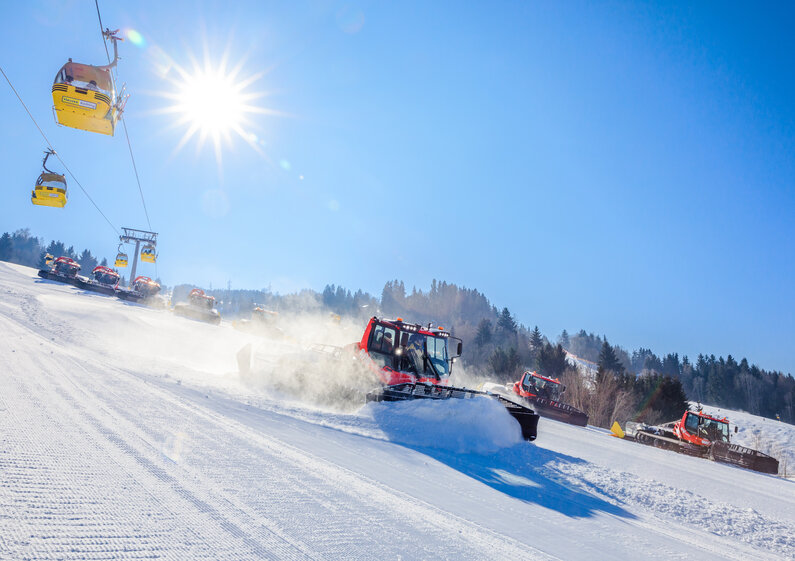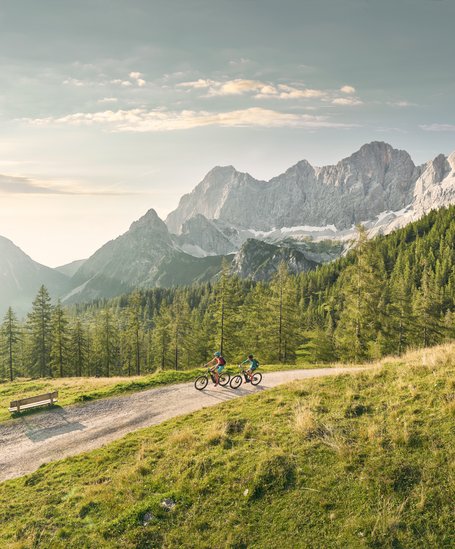Untouched. Pristine. Furrow upon furrow shaped to perfection. If you have ever sliced down a freshly groomed piste, you already know: The high you experience is almost indescribable in words. You have to feel it, sense it, “ski it”. But how is an excellent piste created? What and whom does it require? We will take a look behind the scenes on your behalf.
At the end of the day of skiing, when the lifts are parked away for the night, that’s when the workday for the snowgroomer operators begins. They start up their high-tech equipment and trundle out on their mission to restore the pistes on the ski mountains of the Schladming-Dachstein Region to tip-top condition. “Even if ultramodern snowgroomers play a pivotal role – when it comes down to it, it is the person who operates the machine who determines the results. The quality of a ski piste depends to a great extent on the know-how and skills of the person driving the snowgroomer”, emphasizes Daniel Berchthaller, general manager of the lifts on the Reiteralm.
Good “feel for the snow”
In this process, many years of experience and that much-lauded “feel for the snow” are very helpful. Thomas Gürtl, a snowgroomer operator on the Hauser Kaibling, explains: “One of our most important mottos is: shove first, shape second. In the first step, the snow which is being pushed downhill on the fringes of the piste has to be maneuvered into the right position by the driver. This is done using the blade attached to the front of the snowgroomer. The idea is to create a flat area with as much snow as possible in the middle of the piste. Now, in the second step, the tiller mounted on the back of the snowgroomer comes into play. We try to drive as cleanly as possible, overlapping to avoid any unevenness. Driving a snowgroomer is work that demands a fine touch and can only be learned in practice. Making it even more valuable when an experienced driver passes on their knowledge to a younger generation – a process which is particularly important to us in this region.”
Spare, and permanently improve resources
“If you stop getting better, you have stopped being good”, as the famous quotation from Philip Rosenthal goes. That also applies to pistes, the ongoing optimization of which plays an important role for the lifts of the Schladming-Dachstein Region. The Planai-Hochwurzen lifts have, like all the other lifts in the region, created a routine that does precisely that – the monthly piste checkup. Just like with a visit to the doctor, technical director Thomas Pitzer, together with the on-site piste managers and snowgroomer operators, carefully examines the “health condition” of each individual piste. All pistes are skied down together with a close eye to every detail. The focus is on weak points, on passages with potential for improvement. The insights which are gained then feed into a resource-friendly snow-management process. Always with the goal of giving all pistes an optimal snow covering. A geodata-based system provides current snow depths for each single meter of the piste, electronically and in real time. These data can be pulled up in the lift offices as well as in the cockpit of the snowgroomer itself. Thomas Pitzer summarizes in these words: “Resource-friendly snow management involves many factors – piste construction, piste maintenance and revegetation in summer, along with efficient use of snowmaking and snow-grooming equipment and the most sparing use of natural resources possible. With so many moving parts, we have many ‘screws’ that we can adjust to finetune the process. It is a permanent improvement process.”
It all begins in summer!
The foundation for an ideal piste is laid during the summer months. On the one hand, the profile is important. If the terrain permits, rather than the piste “sagging” in one direction, you want to keep it as level as possible. On the other, a level subsurface with even vegetation coverage is important for resource-friendly grooming efforts in winter. And since we are on the topic of vegetation: In their revegetation efforts, the ski mountains of the Schladming-Dachstein Region place their trust in the expertise of Agricultural Research and Education Center Gumpenstein, with whom they have cooperated for many years. Together, they have developed and optimized seed blends for alpine terrain and various elevations. Furthermore, on the Hauser Kaibling wooly quadrupeds also contribute to summer piste maintenance. Around 800 sheep graze the alpine pastures and roughly 110 hectares of pistes. In turn, this reduces the need for mowing and fertilizing. The sheep actually improve vegetation since these lightweight “lawnmowers” gently compress the ground with their hooves and fertilize it with their dung. This promotes plant growth, which in turn protects the pistes from erosion.
Did you know that …
… the process of sintering is decisive when it comes to the quality of a piste?
Put simply, sintering is the “coalescence of grains of snow”. This process is impacted by various factors, above all the snow temperature, air temperature, the wetness of the snow, as well as the form and dimension of the snow grains. The snowgroomers of today do far more than simply push snow around and compress it. They prepare the “white gold” to the best extent possible to ensure an optimal sintering process. The prime tool for doing this is the tiller installed at the back of the equipment.
… the Reiteralm is the ski mountain awarded the most “quality seals”?
The Reiteralm is the only ski mountain in the Alps to be awarded the Piste Seal of Quality in Gold five times in a row. The Reiteralm received this coveted recognition in the years 2010, 2013, 2015, 2018 and 2021. The International Ski Area Test is a renowned quality check conducted anonymously by more than 200 testers of various nationalities and professions.
… there’s a good reason why steep slopes are groomed with equipment attached to winches?
On the one hand, grooming steep slopes involves considerable risk. Attaching a cable to an anchor point enhances safety and allows a snowgroomer to master even extreme gradients without slipping and sliding. On the other, there is no more efficient method of moving snow uphill in steep terrain. The tension on the cable winch and the speed of the snowgroomer are closely synched. This produces ideal circumstances for moving and tilling the snow. The result: steep pistes that are perfectly groomed.
… piste closure times must be complied with?
Snowgroomers operating on winches may be as much as one kilometer from their anchor point. As it goes about its work, the cable is constantly in motion, kicking to the side as well as up and down. Due to the darkness and because the cable often comes to rest a few centimeters under the snow, it is virtually impossible to see and, therefore, life-threatening. That is why everyone is strictly prohibited from skiing or boarding on a closed piste. Please pay attention to your personal safety!
… an innovative hydropower station was built on the Riesneralm, producing electricity as well as snow?
For this investment in sustainability, the ski area was presented with the Ski Area Test’s award for “Sustainable Energy Management”. For good reason: The hydropower station at the valley station generates twice as much electricity as the ski area needs to operate the lifts, restaurants and snowmakers. The surplus eco-power is fed back into the public energy grid and made available to other consumers.
Further info for you
On the following dates, you can enjoy a look behind the scenes on the Hochwurzen:
• 08.02.2023 • 15.02.2023 • 22.02.2023 • 05.04.2023










